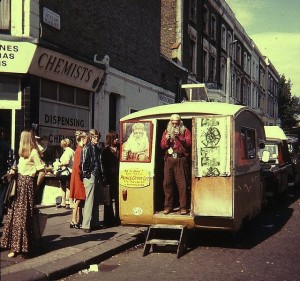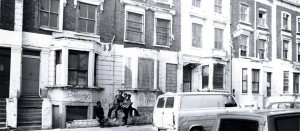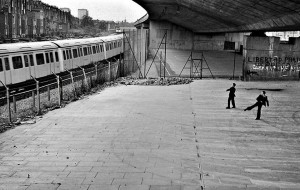As Hawkwind played a series of free gigs under the Westway, pictured on the gatefold sleeve of their 1971 album ‘X In Search of Space’, during which they would merge with the Pink Fairies as Pinkwind, Frendz underground paper (at 305 Portobello Road) made ‘a call to all progressive people; black people smash the racist immigration bill; workers of Britain smash the Industrial Relations bill. All progressive people unite and smash growing fascism. Rally and march July 25, Acklam Road, Ladbroke Grove 2pm. Black Unity and Freedom Party.’
In 1973 the Caribbean Notting Hill Carnival as we know it today was established on Acklam Road, facilitated by Anthony Perry and the Amenity Trust. The Carnival office under the administration of Leslie Palmer was at 3 Acklam Road for two years and then moved to number 9 in the mid 70s, when Selwyn Baptiste became director. At the Carnival 73 ‘Mas in the Ghetto’ Acklam Road was the main thoroughfare of the procession, dotted with reggae sound-systems and ‘electric funk/Afro/black music’ bands including Black Slate on the corner of St Ervan’s Road. In his Carnival memoirs Leslie Palmer recalls his first impressions of the area, Anthony Perry and the trust when he arrived on the scene in 73:
“Going to the North Kensington Amenity Trust at 3 Acklam Road offered me the opportunity to observe the derelict state of the terrace, which had been evacuated as they were close to the flyover and faced it directly. The Amenity Trust occupied the end house of the terrace that had been made functional and just about fit for purpose. Beside Cora, his secretary, there was the light skinned Jamaican worker Dave, who Anthony designated to help settle us in. The trust’s work was challenging as they were the most accessible body that seemingly represented the Council and as such they were the target for occasional grouses from disgruntled residents. Their main brief was to ascertain what amenities could be built on the undeveloped land under the flyover. The bays were empty and rubbish strewn but on the eastern side a small playgroup existed across Acklam from the derelict terrace.
“I might have taken along my blueprints for music points and the route map, and explained to Anthony and Dave what I intended to do. Frank Crichlow and Merle Major turned up and said it was great that I was interested in carrying on the tradition and when they left Anthony Perry introduced me to Tony Soares, whom I knew as the guy who ran the Grass Roots bookshop on Golborne Road and bookstall on the market. He helped me draft fundraising letters and find possible sponsors. Everything needs money and that was at the top of the agenda when we had the first roundtable at which he allocated us a small room and a phone, and explained to us that as the Carnival didn’t have charitable status we would have to use theirs, in order for us to solicit funding.
“Robert ‘Bigga’ Hamilton walked into the Carnival office at number 3 Acklam Road about the second morning after I took over the responsibility of organising the local jump-up. He became my main assistant and together with my partner Geraldine, 15-year-old Donald Francis and his mate Leon Waithe, we organised the Carnival events, certainly in 1973 it was us 4 that carried the brunt of the work. Bigga knew London and he would drive us all over distributing flyers. We would have gone off to Finsbury Park, Stoke Newington, found a little Trini club, left some flyers there with telephone numbers, and sure enough Laurence Noel picked up on that and that was the first costume band that contacted us at the office.”
The photographer/artist Steve Mepsted was inspired by his childhood memories of the Acklam Road adventure playground to create the Orphans 70s street photo blow-up installation in the bays: ‘As a kid of 10 years old in 1973 I would play in the NKPG playground built in the Acklam Road bays – the very site of my installation. I was merely a visitor to the area at that time, travelling each Saturday morning from Redbridge in east London to help my mother on her market stall situated on the land now covered by the market tent. I returned to live here permanently at the age of 22; my decision to do so in no small way informed by my instant love of the area when I was a child.’
Acklam Road in the mid-70s is described in ‘Soft City’ by Jonathan Raban as consisting of: ‘a locked shack with Free Shop spraygunned on it, and old shoes and sofas piled in heaps around it; a makeshift playground under the arches of the motorway with huge crayon faces drawn on the concrete pillars, slogans in whitewash, from Smash the Pigs to Keep Britain White.’ The Free Shop hand sign on the corner of Acklam Road was sprayed with ‘It’s Only Rock’n’Roll’ graffiti, promoting the Rolling Stones’ 1974 single. Emily Young recalled: “Under the motorway was just dead cats. People dumped rubbish and nobody cleared it. My idea was to have big archetypal figures and a continuing landscape of hills and green fields to bring a sense of space and freedom to the concrete bays.”
As Anthony Perry was helping to establish the Notting Hill People’s Carnival, he was attacked in the People’s News (Notting Hill People’s Association’s newsletter) for getting private business funding for the community projects of the Amenity Trust, ‘set up to develop the land under the motorway for the people in the area’, rather than getting the Council to pay. Anthony Perry, North Kensington Amenity Trust director’s diary, June 15 1974: ‘Today there’s a trust management meeting. A great deal of the time is spent getting the papers ready. The morning seems to disappear in a welter of nonsense. At lunchtime we had over a Mrs Kay of an organisation called ARC, Action Resource Centre. They have the good idea to get businesses to give skilled staff to community and charity organisations…
‘While we were talking, we were interrupted by a typical North Kensington event: Mick Gallagher, the so called manager from our Free shop, in fact the squatter in the Free Shop for something like 2 years, burst into our meeting, white faced, and said he had just beaten up his brother, and the Free Shop was on fire. So I left Ian Harker, a member of our management committee who had joined us for the office lunch with Mrs Key, and went over to the Free Shop. The shop was indeed still on fire and lying on the ground was one of the alcoholics from the green. I got a bucket of water and put out the fire, and saw Mick thumping this bloke on the ground, saying “Danny, why did you do it?” It turned out that Mick had told him to piss off on some earlier occasion. His brother had come back and set fire to the Free Shop with Mick in it…
‘The trust meeting was this evening, with Sir Malby Crofton present. It was a very long meeting. It was acrimonious. John O’Malley, Adam Ritchie and Dave Perry had clearly thought out what they were going to do and made a whole series of very strong attacks on trust staff. Everybody got bored. Sir Malby got very bored and left before the end… When I went into the office on Friday morning we’d been broken into again. The previous weekend we had the IBM typewriter stolen, this time we had the Olivetti and the old IBM typewriters stolen together with an adding machine and a certain amount of damage and rampage had been done…’
During the 1976 Notting Hill Carnival riot, the film director Don Letts walked across Portobello Road towards Acklam Road, as Rocco Macaulay began photographing the police charge towards the Westway, where the youths were gathered. Macaulay’s shot of ‘The Clash’ moment when police ran across the Acklam junction became the back cover of the first Clash album and the backdrop of their ‘White Riot’ tour. The Don Letts’ Wild West 10 walk appeared on the sleeve of the ‘Black Market Clash’ album.
As Joe Strummer sang ‘Up and down the Westway, in and out the lights, what a great traffic system’, the Clash were photographed under the flyover on the Free Shop corner of Acklam and Portobello, establishing the site as ground zero of the west London punky reggae party. Acklam Road at the time of the 76 riot appears in the gritty detective film ‘The Squeeze’, starring Stacy Keach and Freddie Starr. In 2007 Mick Jones returned to ‘The Clash’ photo location with his Rock’n’Roll Library exhibition and the Strummerville studio at 2 Acklam Road under the Westway.
When Bob Marley was on the Acklam corner at Lloyd Coxsone’s sound-system in 1977, the Kensington Post reported: ’As reggae music belted out from speakers stacked on the north side of Acklam Road, the latest punch up began to move underneath the flyover to a patch of land which usually houses a happy hippy market.’ The Liberal politician Gerard Mulholland told the West London Observer: “The violence that occurred was stimulated enormously by the existence of 3 fixed-place reggae sound-systems in the vicinity of Acklam Road. The natural consequence of reggae is an emotional build up which makes punk rock’s pseudo-anarchy sound like a vicarage tea party.”
Original source: http://www.colvillecom.com (It’s Your Colville)



